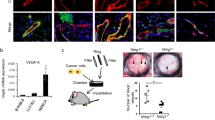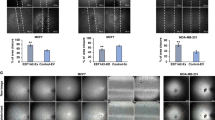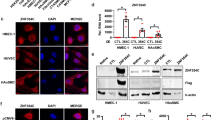Abstract
Current understanding of key transcription factors regulating angiogenesis is limited. Here we show that RNA-cleaving phosphodiester-linked DNA-based enzymes (DNAzymes), targeting a specific motif in the 5′ untranslated region of early growth response (Egr-1) mRNA, inhibit Egr-1 protein expression, microvascular endothelial cell replication and migration, and microtubule network formation on basement membrane matrices. Egr-1 DNAzymes blocked angiogenesis in subcutaneous Matrigel plugs in mice, an observation that was independently confirmed by plug analysis in Egr-1-deficient animals, and inhibited MCF-7 human breast carcinoma growth in nude mice. Egr-1 DNAzymes suppressed tumor growth without influencing body weight, wound healing, blood coagulation or other hematological parameters. These agents inhibited endothelial expression of fibroblast growth factor (FGF)-2, a proangiogenic factor downstream of Egr-1, but not that of vascular endothelial growth factor (VEGF). Egr-1 DNAzymes also repressed neovascularization of rat cornea. Thus, microvascular endothelial cell growth, neovascularization, tumor angiogenesis and tumor growth are processes that are critically dependent on Egr-1.
This is a preview of subscription content, access via your institution
Access options
Subscribe to this journal
Receive 12 print issues and online access
$209.00 per year
only $17.42 per issue
Buy this article
- Purchase on Springer Link
- Instant access to full article PDF
Prices may be subject to local taxes which are calculated during checkout






Similar content being viewed by others
References
Folkman, J. Tumor angiogenesis: therapeutic implications. N. Engl. J. Med. 285, 1182–1186 (1971).
Folkman, J. Anti-angiogenesis: new concept for therapy of solid tumors. Ann. Surg. 175, 409–416 (1972).
Kerbel, R. & Folkman, J. Clinical translation of angiogenesis inhibitors. Nat. Rev. Cancer 2, 727–739 (2002).
Sukhatme, V.P. et al. A zinc-finger encoding gene corregulated with c-Fos during growth and differentiation and after depolarization. Cell 53, 37–43 (1988).
Gashler, A. & Sukhatme, V. Early growth response protein 1 (Egr-1): prototype of a zinc-finger family of transcription factors. Prog. Nucl. Acid Res. 50, 191–224 (1995).
Khachigian, L.M., Lindner, V., Williams, A.J. & Collins, T. Egr-1-induced endothelial gene expression: a common theme in vascular injury. Science 271, 1427–1431 (1996).
Khachigian, L.M. & Collins, T. Inducible expression of Egr-1-dependent genes: a paradigm of transcriptional activation in vascular endothelium. Circ. Res. 81, 457–461 (1997).
Santoro, S.W. & Joyce, G.F. A general purpose RNA-cleaving DNA enzyme. Proc. Natl. Acad. Sci. USA 94, 4262–4266 (1997).
Montesano, R., Orci, L. & Vassalli, P. In vitro rapid organization of endothelial cells into capillary-like networks is promoted by collagen matrices. J. Cell Biol. 97, 1648–1652 (1983).
Cieslak, M. et al. DNAzymes to beta 1 and beta 3 mRNA down-regulate expression of the targeted integrins and inhibit endothelial cell capillary tube formation in fibrin and Matrigel. J. Biol. Chem. 277, 6779–6787 (2002).
Lee, S. et al. Luteinizing hormone deficiency and female infertility in mice lacking the transcription factor NGFI-A (Egr-1). Science 273, 1219–1221 (1996).
Fournier, G.A., Lutty, G.A., Watt, S., Fenselau, A. & Patz, A. A corneal micropocket assay for angiogenesis in the rat eye. Invest. Ophthalmol. Vis. Sci. 21, 351–354 (1981).
Parry, T.J. et al. Bioactivity of anti-angiogenic ribozymes targeting Flt-1 and KDR mRNA. Nucleic Acids Res. 27, 2569–2577 (1999).
Lowe, H.C. et al. Catalytic oligodeoxynucleotides define a key regulatory role for early growth response factor-1 in the porcine model of coronary in-stent restenosis. Circ. Res. 89, 670–677 (2001).
Shing, Y. et al. Heparin affinity: purification of a tumor-derived capillary endothelial cell growth factor. Science 223, 1296–1298 (1984).
Santiago, F.S., Lowe, H.C., Day, F.L., Chesterman, C.N. & Khachigian, L.M. Egr-1 induction by injury is triggered by release and paracrine activation by fibroblast growth factor-2. Am. J. Pathol. 154, 937–944 (1999).
Wang, D., Mayo, M.W. & Baldwin, A.S., Jr. Basic fibroblast growth factor transcriptional autoregulation requires EGR-1. Oncogene 14, 2291–2299 (1997).
Biesiada, E., Razandi, M. & Levin, E.R. Egr-1 activates basic fibroblast growth factor transcription. J. Biol. Chem. 271, 18576–18581 (1996).
McLeskey, S.W. et al. Tumor growth of FGF or VEGF transfected MCF-7 breast carcinoma cells correlates with density of specific microvessels independent of the transfected angiogenic factor. Am. J. Pathol. 153, 1993–2006 (1998).
McLeskey, S.W. et al. Fibroblast growth factor overexpressing breast carcinoma cells as models of angiogenesis and metastasis. Breast Cancer Res. Treat. 39, 103–117 (1996).
Zhang, L., Kharbanda, S., McLeskey, S.W. & Kern, F.G. Overexpression of fibroblast growth factor 1 in MCF-7 breast cancer cells facilitates tumor cell dissemination but does not support the development of macrometastases in the lungs or lymph nodes. Cancer Res. 59, 5023–5029 (1999).
McLeskey, S.W. et al. Effects of AGM-1470 and pentosan polysulphate on tumorigenicity and metastasis of FGF-transfected MCF-7 cells. Br. J. Cancer 73, 1053–1062 (1996).
Zhang, L., Kharabanda, S., Hanfelt, J. & Kern, F.G. Both autocrine and paracrine effects of transfected acidic fibroblast growth factor are involved in the estrogen-independent and antiestrogen-resistant growth of MCF-7 breast cancer cells. Cancer Res. 58, 352–361 (1998).
Karpanen, T. et al. Vascular endothelial growth factor C promotes tumor lymphangiogenesis and intralymphatic tumor growth. Cancer Res. 61, 1786–1790 (2001).
Gille, J., Swerlick, R.A. & Caughman, S.W. Transforming growth factor-alpha-induced transcriptional activation of the vascular permeability factor (VPF/VEGF) gene requires AP-2-dependent DNA binding and transactivation. EMBO J. 16, 750–759 (1997).
Finkenzeller, G., Sparacio, A., Technau, A., Marme, D. & Siemeister, G. Sp1 recognition sites in the proximal promoter of the human vascular endothelial growth factor gene are essential for platelet-derived growth factor-induced gene expression. Oncogene 15, 669–676 (1997).
Li, Y. et al. Active immunization against the vascular endothelial growth factor receptor flk1 inhibits tumor angiogenesis and metastasis. J. Exp. Med. 195, 1575–1584 (2002).
Prewett, M. et al. Antivascular endothelial growth factor receptor (fetal liver kinase 1) monoclonal antibody inhibits tumor angiogenesis and growth of several mouse and human tumors. Cancer Res. 59, 5209–5218 (1999).
Shiose, S. et al. Gene transfer of a soluble receptor of VEGF inhibits the growth of experimental eyelid malignant melanoma. Invest. Opthalmol. Vis. Sci. 41, 2395–2403 (2000).
Dennis, P.A. & Rifkin, D.B. Studies on the role of basic fibroblast growth factor in vivo: inability of neutralizing antibodies to block tumor growth. J Cell. Physiol. 144, 84–98 (1990).
Ogawa, T., Takayama, K., Takakura, N., Kitano, S. & Ueno, H. Anti-tumor angiogenesis therapy using soluble receptors: enhanced inhibition of tumor growth when soluble fibroblast growth factor receptor-1 is used with soluble vascular endothelial growth factor receptor. Cancer Gene Ther. 9, 633–640 (2002).
Wedge, S.R. et al. ZD6474 inhibits vascular endothelial growth factor signaling, angiogenesis, and tumor growth following oral administration. Cancer Res. 62, 4645–4655 (2002).
Battegay, E.J. Angiogenesis: mechanistic insights, neovascular diseases, and therapeutic prospects. J. Mol. Med. 73, 333–346 (1995).
Haas, T.L., Stitelman, D., Davis, S.J., Apte, S.S. & Madri, J.A. Egr-1 mediates extracellular matrix-driven transcription of membrane type 1 matrix metalloproteinase. J. Biol. Chem. 274, 22679–22685 (1999).
Goldberg, E.P., Hadba, A.R., Almond, B.A. & Marotta, J.S. Intratumoral cancer chemotherapy and immunotherapy: opportunities for nonsystemic preoperative drug delivery. J. Pharm. Pharmacol. 54, 159–180 (2002).
Usman, N. & Blatt, L.M. Nuclease-resistant synthetic ribozymes: developing a new class of therapeutics. J. Clin. Invest. 106, 1197–1202 (2000).
Pavco, P.A. et al. Antitumor and antimetastatic activity of ribozymes targeting the messenger RNA of vascular endothelial growth factor receptors. Clin. Cancer Res. 6, 2094–2103 (2000).
Masood, R. et al. Vascular endothelial growth factor (VEGF) is an autocrine growth factor for VEGF receptor-positive human tumors. Blood 98, 1904–1913 (2001).
Herold-Mende, C. et al. Expression and functional significance of vascular endothelial growth factor receptors in human tumor cells. Lab. Invest. 79, 1573–1782 (1999).
Eyetech. Preclinical and phase 1A clinical evaluation of an anti-VEGF pegylated aptamer (EYE001) for the treatment of exudative age-related macular degeneration. Retina 22, 143–152 (2002).
Khachigian, L.M. DNAzymes: cutting a path to a new class of therapeutics. Curr. Opin. Mol. Ther. 4, 119–121 (2002).
Santiago, F.S. et al. New DNA enzyme targeting Egr-1 mRNA inhibits vascular smooth muscle proliferation and regrowth factor injury. Nat. Med. 11, 1264–1269 (1999).
Khachigian, L.M., Fahmy, R.G., Zhang, G., Bobryshev, Y.V. & Kaniaros, A. c-Jun regulates vascular smooth muscle cell growth and neointima formation after arterial injury: inhibition by a novel DNAzyme targeting c-Jun. J. Biol. Chem. 277, 22985–22991 (2002).
Chan, J.C., Duszczyszyn, D.A., Castellino, F.J. & Ploplis, V.A. Accelerated skin wound healing in plasminogen activator inhibitor-1-deficient mice. Am. J. Pathol. 159, 1681–1688 (2001).
Visvanathan, S., Geczy, C.L., Harmer, J.A. & McNeil, H.P. Monocyte tissue factor induction by activation of beta 2-glycoprotein-I-specific T lymphocytes is associated with thrombosis and fetal loss in patients with antiphospholipid antibodies. J. Immunol. 165, 2258–2262 (2000).
Acknowledgements
We thank L. Chalifour and J. Milbrandt for Egr-1-deficient mice, J. Hood and D. Cheresh for CAM sections, W. Gerlach and J. Pimanda for helpful comments, and H. Zreiqat and W. Lipworth for technical assistance. This work was supported by Johnson & Johnson Research Pty. Limited, a National Health and Medical Research Council (NHMRC) Program Grant and a New South Wales Health Department Research and Infrastructure Grant. L.M.K. is a Principal Research Fellow of the NHMRC.
Author information
Authors and Affiliations
Corresponding author
Ethics declarations
Competing interests
The authors declare no competing financial interests.
Rights and permissions
About this article
Cite this article
Fahmy, R., Dass, C., Sun, LQ. et al. Transcription factor Egr-1 supports FGF-dependent angiogenesis during neovascularization and tumor growth. Nat Med 9, 1026–1032 (2003). https://doi.org/10.1038/nm905
Received:
Accepted:
Published:
Issue Date:
DOI: https://doi.org/10.1038/nm905
This article is cited by
-
Nuclear PD-L1 promotes EGR1-mediated angiogenesis and accelerates tumorigenesis
Cell Discovery (2023)
-
N6-methyladenosine reader YTHDF2 promotes multiple myeloma cell proliferation through EGR1/p21cip1/waf1/CDK2-Cyclin E1 axis-mediated cell cycle transition
Oncogene (2023)
-
Liver endothelial cells in NAFLD and transition to NASH and HCC
Cellular and Molecular Life Sciences (2023)
-
Programmable CRISPR-Cas9 microneedle patch for long-term capture and real-time monitoring of universal cell-free DNA
Nature Communications (2022)
-
Angiogenic gene networks are dysregulated in opioid use disorder: evidence from multi-omics and imaging of postmortem human brain
Molecular Psychiatry (2021)



